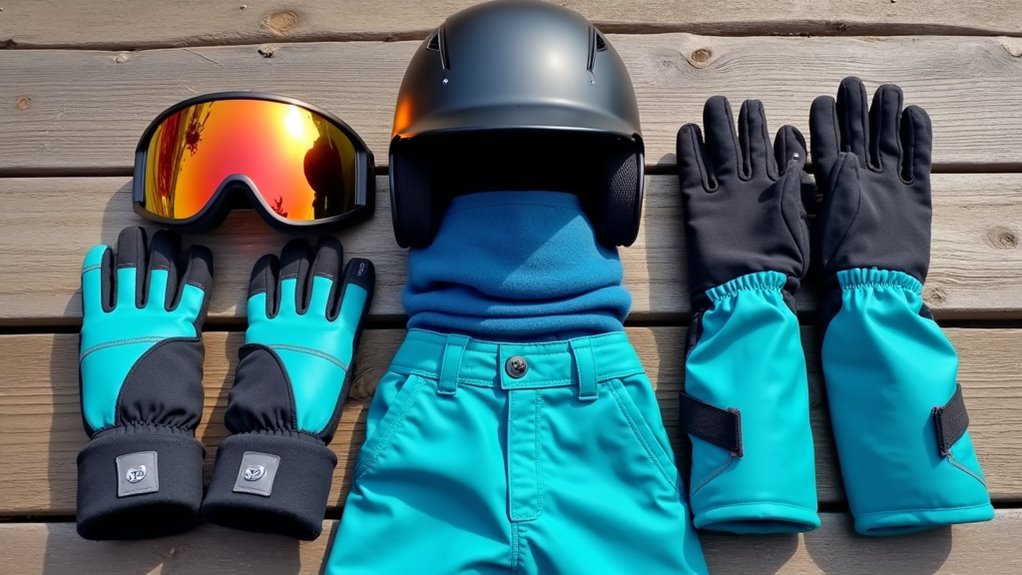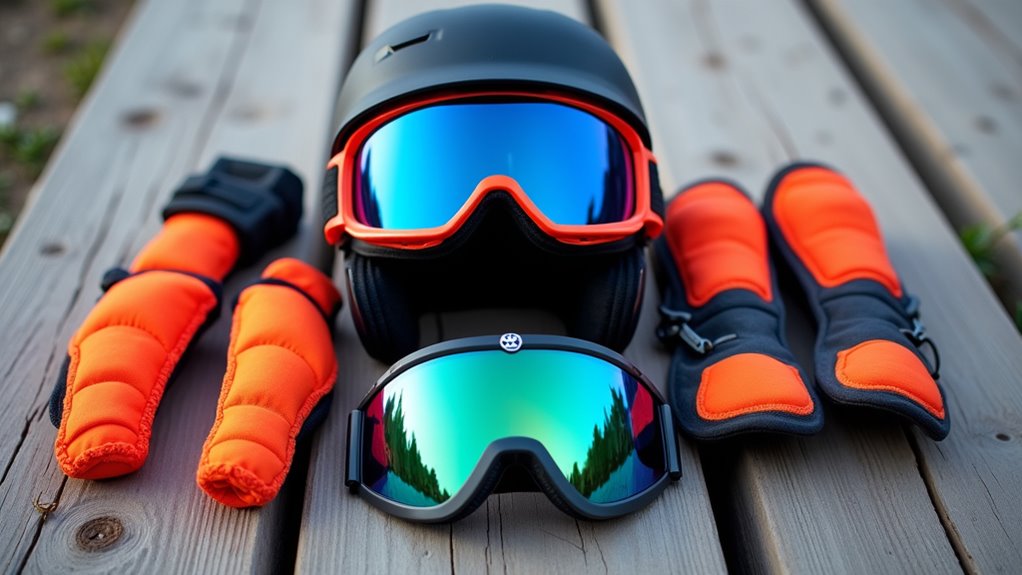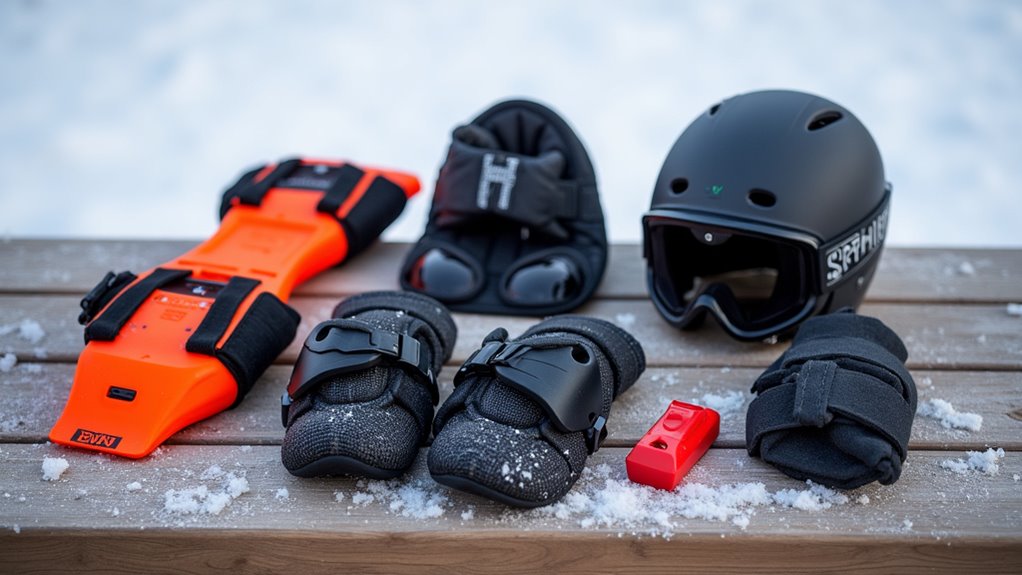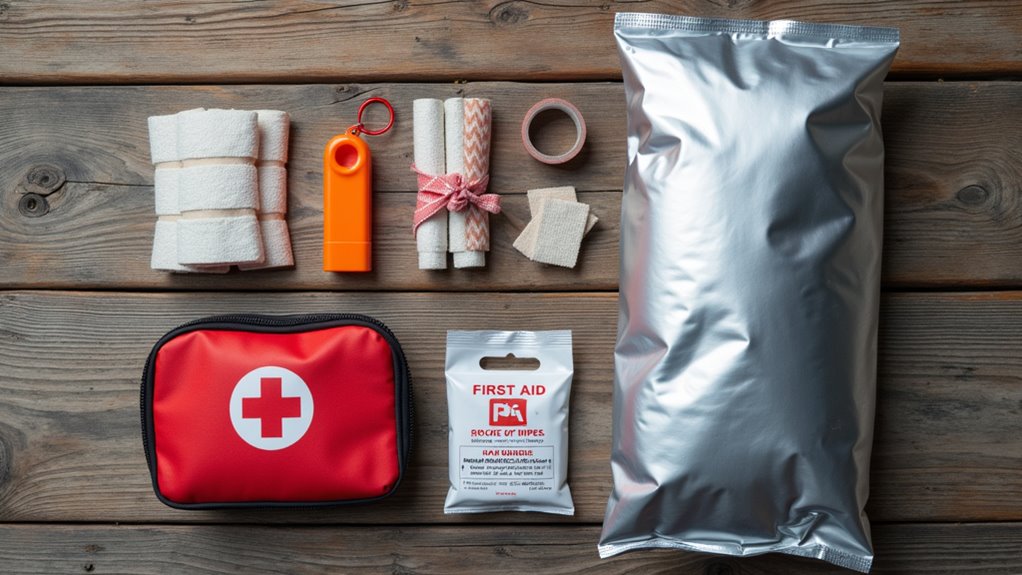Physical Address
304 North Cardinal St.
Dorchester Center, MA 02124
Physical Address
304 North Cardinal St.
Dorchester Center, MA 02124

Need-to-know snowboarding accessories that protect you on the slopes and enhance your riding experience, from basic gear to essential upgrades.
Just like a pilot’s pre-flight checklist can mean the difference between a smooth journey and disaster, your snowboarding gear checklist deserves careful attention. You’ll find that having the right accessories isn’t just about comfort—it’s about safety and making the most of your time on the slopes. Whether you’re a first-timer or a seasoned rider, knowing which gear to prioritize can save you money while keeping you protected. Let’s explore what you really need before hitting the mountain.

When it comes to snowboarding safety, your protective gear serves as your first line of defense against injuries on the slopes. You should aim to start with a properly fitted helmet, as head injuries make up about 20% of snowboarding accidents. Proper fit is crucial for getting the most out of your helmet’s protection.
Don’t skip the wrist guards – they’re vital since most people instinctively try to break falls with their hands. For complete protection, you’ll require knee pads to cushion impacts and hip protectors to safeguard your lower back.
Wrist guards are essential safety gear since falling is inevitable – protect your hands and invest in quality knee and hip protection.
Consider adding a torso protector under your jacket for upper body safety. The good news is that protective gear is affordable and available for all skill levels.
When shopping, look for gear that meets safety certification standards and offers good flexibility. Regular inspections of your gear will guarantee it remains effective for many seasons.
Since your comfort and warmth on the slopes starts from the inside out, choosing the right base layer clothing can make or break your snowboarding experience. You should consider investing in snug-fitting pieces made from merino wool or synthetic materials like polyester – just avoid cotton, as it’ll leave you cold and wet.
For maximum protection, opt for a high-neck top with long sleeves and full-length leggings featuring flatlock seams to prevent chafing. These pieces should wick moisture away from your skin while maintaining warmth. Many riders prefer using moisture-wicking long underwear as their foundation layer for staying dry and comfortable throughout the day. Proper skiing equipment is essential for a successful snowboarding adventure.
Don’t forget your extremities – wool or synthetic blend socks, thin glove liners, and a thermal beanie are essential accessories. If you’re on a budget, consider blended fabrics that combine the benefits of both wool and synthetics, offering good performance at a lower price point.

Building on your base layer foundation, selecting the right weather-resistant outerwear takes your snowboarding protection to the next level. You should focus on jackets that match your riding conditions and budget.
For cold environments, go with insulated jackets featuring synthetic materials, while shell jackets work better for warmer days or high-intensity runs. Your terrain choices will impact jacket selection since different types of terrain require varying levels of protection and mobility.
Look for key features that’ll keep you dry: a solid waterproof rating (at least 10K), reliable seam sealing, and DWR coating.
If you’re trying to save money while maximizing versatility, consider a 3-in-1 jacket that combines a waterproof shell with a removable insulated liner.
Don’t forget to check for practical features like helmet-compatible hoods, adjustable cuffs, and ventilation zips for temperature control.
As you learn about selecting your snowboarding setup, understanding boot and binding components becomes vital for both performance and safety. Your bindings’ baseplate connects to the board while distributing your weight, and the highback provides essential edge control.
You’ll need reliable ankle and toe straps with smooth-operating ratchets to keep your boots secure. The splitboard binding hinges allow natural movement when climbing uphill in ski mode. When choosing bindings, make sure they’re compatible with your boot size and riding style.
All-mountain bindings offer versatility if you’re on a budget, while specialized freestyle or freeride options cater to specific needs. Don’t forget to check for tool-free adjustments and proper cushioning features.
Regular maintenance is key – inspect your hardware before riding, keep ratchets clean, and store your gear properly to extend its lifespan.

When hitting the slopes, your safety equipment deserves as much attention as your board and boots. Start with a quality helmet featuring MIPS technology – it’s non-negotiable for preventing head injuries and concussions.
Safety gear is just as crucial as your snowboarding equipment. A MIPS helmet isn’t optional – it’s essential protection for your brain.
You’ll also want wrist guards, which can be standalone or built into gloves, to protect against common falling injuries. Eight weeks of healing is typically required even for minor wrist injuries.
Don’t skip impact protection. Knee pads, elbow guards, and padded shorts will save you from painful bruises and potential fractures.
If you’re planning to tackle the terrain park, consider investing in body armor to protect your chest, back, and shoulders.
Finally, grab some goggles for visibility and UV protection, and add a neck gaiter to stay warm.
While quality safety gear isn’t cheap, it’s far less expensive than medical bills.
Beyond the essential safety gear, comfort accessories can make or break your day on the slopes. You should make an effort to invest in quality thermal layers and waterproof outer shells to stay warm and dry.
Don’t skimp on good socks and gloves – cold feet and hands can quickly end your fun. Merino wool and synthetic blend socks provide superior moisture wicking. Essential winter camping boots are crucial for supporting your feet and keeping them warm and dry on the slopes.
For convenience, pack a hydration system and some energy-rich snacks to keep you going without frequent stops. Hand warmers are inexpensive lifesavers on frigid days.
If you’re riding with friends, consider a Cardo Packtalk system for easy communication. A small multi-tool can save you from equipment hassles mid-run.
Remember to protect yourself from the elements with sunscreen and lip balm – mountain sun is intense.
A basic smartphone case and power bank will keep you connected without risking your device.

Every snowboarder needs three key categories of emergency supplies: basic first aid, trauma care, and survival tools.
For basic first aid, pack sterile gauze, medical gloves, and antibiotic ointment. Don’t forget pain relievers like ibuprofen and some moleskin for those inevitable boot blisters.
For trauma care, you’ll need a CPR mask, hemostatic agent, and trauma shears – these aren’t expensive but could save a life. Purchase only reliable CAT tourniquets rather than cheaper alternatives that might fail when needed most.
Your survival tools should include a space blanket, headlamp, and multi-tool.
You can build this kit gradually to spread out the cost. Start with the essentials: bandages, tape, and basic medications.
Add the trauma supplies next, then the survival tools. Keep everything in a waterproof container that’s easily accessible in your snowboarding pack.
Three essential storage and transport solutions will protect your snowboarding investment: home storage, vehicle transport, and travel cases.
At home, you’ll want wall-mounted racks or under-bed storage to keep your gear organized and protected from moisture and dust. Wall racks double as display pieces, while rolling bins make excellent use of under-bed space. Using Baltic birch construction ensures your storage solutions will withstand years of use.
Proper storage protects your snowboarding investment while maximizing space – wall racks showcase gear, while under-bed solutions keep equipment safe and organized.
For your vehicle, consider investing in a reliable roof rack system or trunk organizer. These allow you to transport your gear safely while keeping the interior of your car clean and spacious.
When traveling longer distances, opt for either a hardshell case for maximum protection or a softshell bag with wheels for easier handling. Look for cases with padded interiors and secure locking mechanisms to safeguard your equipment during transit.
Pack your perfect snowboarding provisions purposefully, prioritizing protection and practicality. You’ll save serious cash by selecting smart, sustainable gear that’ll serve you season after season. Remember to regularly replace worn items and routinely review your safety equipment. Whether you’re a beginner or pro, proper preparation prevents poor performance. Stay safe, stay supplied, and you’ll surely shred the slopes successfully!